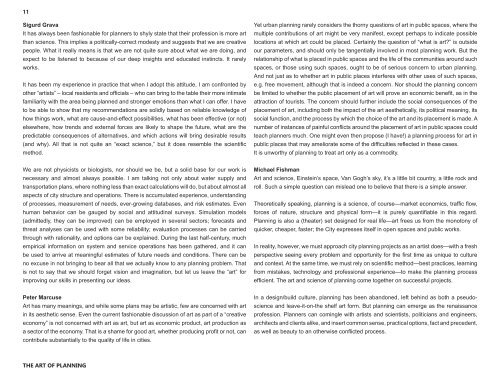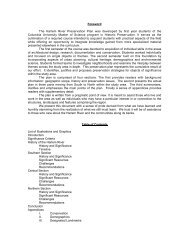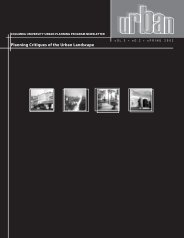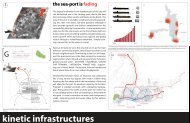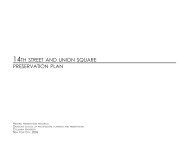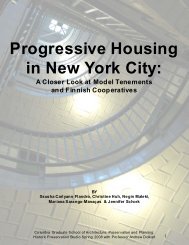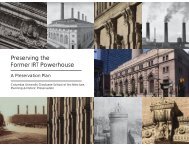The Art of Planning - Columbia University Graduate School of ...
The Art of Planning - Columbia University Graduate School of ...
The Art of Planning - Columbia University Graduate School of ...
Create successful ePaper yourself
Turn your PDF publications into a flip-book with our unique Google optimized e-Paper software.
11<br />
Sigurd Grava<br />
It has always been fashionable for planners to shyly state that their pr<strong>of</strong>ession is more art<br />
than science. This implies a politically-correct modesty and suggests that we are creative<br />
people. What it really means is that we are not quite sure about what we are doing, and<br />
expect to be listened to because <strong>of</strong> our deep insights and educated instincts. It rarely<br />
works.<br />
It has been my experience in practice that when I adopt this attitude, I am confronted by<br />
other “artists” – local residents and <strong>of</strong>ficials – who can bring to the table their more intimate<br />
familiarity with the area being planned and stronger emotions than what I can <strong>of</strong>fer. I have<br />
to be able to show that my recommendations are solidly based on reliable knowledge <strong>of</strong><br />
how things work, what are cause-and-effect possibilities, what has been effective (or not)<br />
elsewhere, how trends and external forces are likely to shape the future, what are the<br />
predictable consequences <strong>of</strong> alternatives, and which actions will bring desirable results<br />
(and why). All that is not quite an “exact science,” but it does resemble the scientific<br />
method.<br />
Yet urban planning rarely considers the thorny questions <strong>of</strong> art in public spaces, where the<br />
multiple contributions <strong>of</strong> art might be very manifest, except perhaps to indicate possible<br />
locations at which art could be placed. Certainly the question <strong>of</strong> “what is art?” is outside<br />
our parameters, and should only be tangentially involved in most planning work. But the<br />
relationship <strong>of</strong> what is placed in public spaces and the life <strong>of</strong> the communities around such<br />
spaces, or those using such spaces, ought to be <strong>of</strong> serious concern to urban planning.<br />
And not just as to whether art in public places interferes with other uses <strong>of</strong> such spaces,<br />
e.g. free movement, although that is indeed a concern. Nor should the planning concern<br />
be limited to whether the public placement <strong>of</strong> art will prove an economic benefit, as in the<br />
attraction <strong>of</strong> tourists. <strong>The</strong> concern should further include the social consequences <strong>of</strong> the<br />
placement <strong>of</strong> art, including both the impact <strong>of</strong> the art aesthetically, its political meaning, its<br />
social function, and the process by which the choice <strong>of</strong> the art and its placement is made. A<br />
number <strong>of</strong> instances <strong>of</strong> painful conflicts around the placement <strong>of</strong> art in public spaces could<br />
teach planners much. One might even then propose (I have!) a planning process for art in<br />
public places that may ameliorate some <strong>of</strong> the difficulties reflected in these cases.<br />
It is unworthy <strong>of</strong> planning to treat art only as a commodity.<br />
We are not physicists or biologists, nor should we be, but a solid base for our work is<br />
necessary and almost always possible. I am talking not only about water supply and<br />
transportation plans, where nothing less than exact calculations will do, but about almost all<br />
aspects <strong>of</strong> city structure and operations. <strong>The</strong>re is accumulated experience, understanding<br />
<strong>of</strong> processes, measurement <strong>of</strong> needs, ever-growing databases, and risk estimates. Even<br />
human behavior can be gauged by social and attitudinal surveys. Simulation models<br />
(admittedly, they can be improved) can be employed in several sectors; forecasts and<br />
threat analyses can be used with some reliability; evaluation processes can be carried<br />
through with rationality, and options can be explained. During the last half-century, much<br />
empirical information on system and service operations has been gathered, and it can<br />
be used to arrive at meaningful estimates <strong>of</strong> future needs and conditions. <strong>The</strong>re can be<br />
no excuse in not bringing to bear all that we actually know to any planning problem. That<br />
is not to say that we should forget vision and imagination, but let us leave the “art” for<br />
improving our skills in presenting our ideas.<br />
Michael Fishman<br />
<strong>Art</strong> and science, Einstein’s space, Van Gogh’s sky, it’s a little bit country, a little rock and<br />
roll. Such a simple question can mislead one to believe that there is a simple answer.<br />
<strong>The</strong>oretically speaking, planning is a science, <strong>of</strong> course—market economics, traffic flow,<br />
forces <strong>of</strong> nature, structure and physical form—it is purely quantifiable in this regard.<br />
<strong>Planning</strong> is also a (theater) set designed for real life—art frees us from the monotony <strong>of</strong><br />
quicker, cheaper, faster; the City expresses itself in open spaces and public works.<br />
In reality, however, we must approach city planning projects as an artist does—with a fresh<br />
perspective seeing every problem and opportunity for the first time as unique to culture<br />
and context. At the same time, we must rely on scientific method—best practices, learning<br />
from mistakes, technology and pr<strong>of</strong>essional experience—to make the planning process<br />
efficient. <strong>The</strong> art and science <strong>of</strong> planning come together on successful projects.<br />
Peter Marcuse<br />
<strong>Art</strong> has many meanings, and while some plans may be artistic, few are concerned with art<br />
in its aesthetic sense. Even the current fashionable discussion <strong>of</strong> art as part <strong>of</strong> a “creative<br />
economy” is not concerned with art as art, but art as economic product, art production as<br />
a sector <strong>of</strong> the economy. That is a shame for good art, whether producing pr<strong>of</strong>it or not, can<br />
contribute substantially to the quality <strong>of</strong> life in cities.<br />
In a design/build culture, planning has been abandoned, left behind as both a pseudoscience<br />
and leave-it-on-the shelf art form. But planning can emerge as the renaissance<br />
pr<strong>of</strong>ession. Planners can comingle with artists and scientists, politicians and engineers,<br />
architects and clients alike, and insert common sense, practical options, fact and precedent,<br />
as well as beauty to an otherwise conflicted process.<br />
THE ART OF PLANNING


